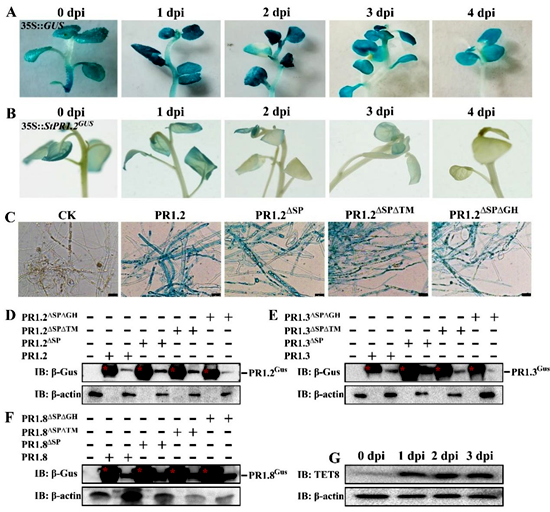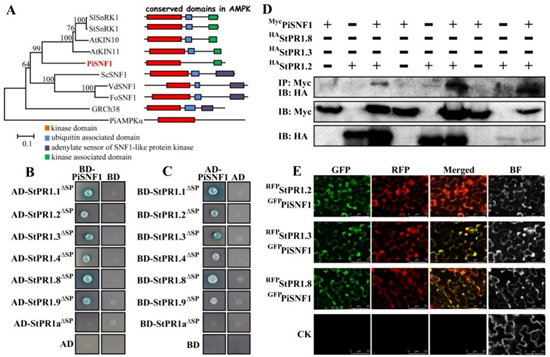The Molecular Mechanism of Pathogenesis Related Protein 1 against Potato Late Blight
Recently, the Innovation Team of Functional Plant Cultivation and Application, Institute of Urban Agriculture, Chinese Academy of Agricultural Sciences (IUA, CAAS), has clarified the molecular mechanism of Pathogenesis-Related Protein 1 (PR1) against potato late blight. The relevant research results were published in the Journal of Advanced Research with the title “Pathogenesis-related protein 1 suppresses oomycete pathogen by targeting against AMPK kinase complex”.
Potato late blight is a devastating disease caused by the oomycete Phytophthora infestans, resulting in stem death and tuber rot. It is one of the most harmful and prevalent crop diseases in the world, causing an estimated $20 billion economic losses annually. The PR1 proteins induced by pathological conditions during plant-pathogen interaction play a crucial role in disease resistance, and trigger host systemic acquired immune resistance. However, the mechanisms by which they inhibit pathogens and their targets in pathogens remain poorly understood. Given the sterol-defect and high sensitivity of P. infestans to PR1 proteins, the Solanum tuberosum-P. infestans pathosystem was used to investigate whether host PR1 proteins mediate cross-kingdom anti-oomycete activity.
Results showed that upon pathogen infection, PR1 proteins were induced, and the host could deliver secretory PR1 into P. infestans to inhibit its vegetative growth and pathogenicity. The translocated PR1 targeted the subunits of the AMPK kinase complex in P. infestans, thus affecting the AMPK-driven phosphorylation of downstream target proteins, preventing ROS homeostasis, and down-regulating the expression of RxLR effectors. The results provide novel insights into the molecular function of PR1 in protecting plants against pathogen infection, and uncover a potential target for preventing pre- and post-harvest late blight.
This work was funded by the National Key R&D Program of China (2017YFE0115500), the National Natural Science Foundation of China (31801911), and Science and Technology Innovation Project of the CAAS (No.34-IUA-02).
Link for this paper: https://authors.elsevier.com/sd/article/S2090-1232(22)00033-9.
By Luo Xiumei (luoxiumei@caas.cn)

Fig.1 Cross-kingdom translocation of StPR1 from host to Phytophthora infestans in vivo and in vitro.

Fig. 2 The catalytic subunit (PiSNF1) of AMPK is the target of StPR1.
-
 Apr 18, 2024Opening Ceremony of the Training Workshop on Wheat Head Scab Resistance Breeding and Pest Control in Africa Held in CAAS
Apr 18, 2024Opening Ceremony of the Training Workshop on Wheat Head Scab Resistance Breeding and Pest Control in Africa Held in CAAS -
 Apr 03, 2024IPPCAAS Co-organized the Training Workshop on Management and Application of Biopesticides in Nepal
Apr 03, 2024IPPCAAS Co-organized the Training Workshop on Management and Application of Biopesticides in Nepal -
 Mar 28, 2024Delegation from the School of Agriculture and Food Science of University College Dublin, Ireland Visit to IAS, CAAS
Mar 28, 2024Delegation from the School of Agriculture and Food Science of University College Dublin, Ireland Visit to IAS, CAAS -
 Mar 25, 2024Director of World Food Prize Foundation visited GSCAAS
Mar 25, 2024Director of World Food Prize Foundation visited GSCAAS -
 Mar 20, 2024Institute of Crop Sciences (ICS) and Syngenta Group Global Seeds Advance Collaborative Research in the Seed Industry
Mar 20, 2024Institute of Crop Sciences (ICS) and Syngenta Group Global Seeds Advance Collaborative Research in the Seed Industry
